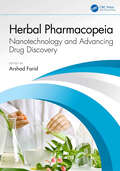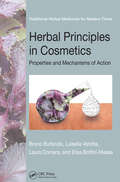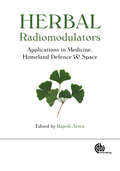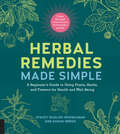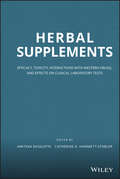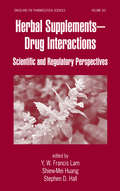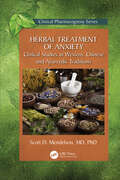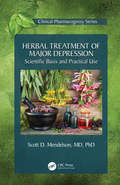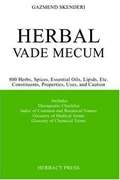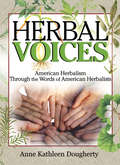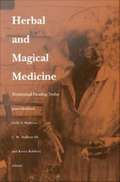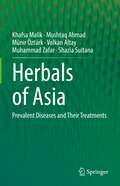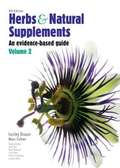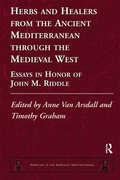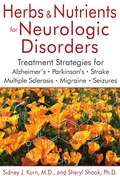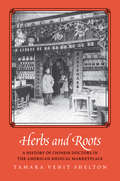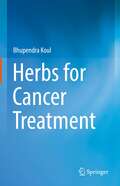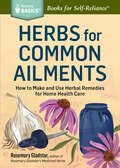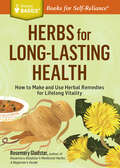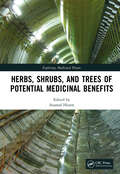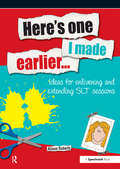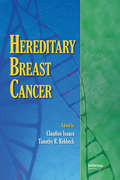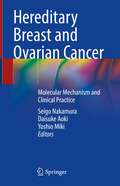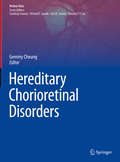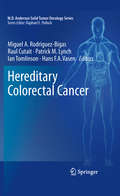- Table View
- List View
Herbal Pharmacopeia: Nanotechnology and Advancing Drug Discovery
by Arshad FaridThis book comprehensively explores the intersection between traditional herbal medicine and cutting-edge nanotechnology. The chapters introduce modern techniques used in herbal extraction and analysis. The principles of drug discovery from plants are discussed, with a focus on the identification and development of bioactive compounds that have therapeutic potential. It discusses the pharmacological properties, biotechnological approaches in drug development, and challenges in the formulation and standardization of herbal medicines. Emerging trends and applications of nanotechnology in herbal pharmacotherapy, such as nanoparticle synthesis, enhanced bioavailability using nanocarriers, safety assessments, novel and targeted delivery systems, and regulatory considerations, are thoroughly discussed. Additionally, it includes a comparative analysis of traditional and nano-formulated approaches and their implementation in clinical settings. Towards the end, the book reviews the regulatory considerations for herbal products and future perspectives in herbal pharmacopeia. This book is intended for researchers, clinicians, and professionals in herbal medicine, pharmacology, and nanotechnology.
Herbal Principles in Cosmetics: Properties and Mechanisms of Action (Traditional Herbal Medicines for Modern Times)
by Luisella Verotta Bruno Burlando Laura Cornara Elisa Bottini-MassaInterest in the molecular and mechanistic aspects of cosmetic research has grown exponentially during the past decade. Herbal Principles in Cosmetics: Properties and Mechanisms of Action critically examines the botanical, ethnopharmacological, phytochemical, and molecular aspects of botanical active ingredients used in cosmetics. Along with dermato
Herbal Radiomodulators: Applications in Medicine, Homeland Defence and Space
by Rajesh AroraThis book discusses the potential of radiation countermeasure agents and radiosensitizers of herbal origin, their multifaceted mode of action, specifically the use of the former in a nuclear theatre of operations, rescue operations and deep space missions in addition to their application during radiotherapy.
Herbal Remedies Made Simple: A Beginner's Guide to Using Plants, Herbs, and Flowers for Health and Well-Being
by Susan Gregg Stacey Dugliss-WesselmanA do-it-yourself guide to natural healing products, with instructions on choosing plants and recipes for creating alternative wellness solutions at home.Natural alternatives to traditional medicines are everywhere, even right outside your door! Herbal Remedies Made Simple is an easy and fun way to learn about the many different healing herbs that grow all around us but we seldom see. The best part: once you’re familiar with the natural healing herbs around you, Herbal Remedies Made Simple provides you with instructions on creating your own DIY herbal remedies at home.This unique guide book splits its pages in half. The top halves of the pages detail different remedies and recipes for health, personal care, and home care. The bottom pages provide reference material on the herbs used in the project above; detailing the plant’s medicinal properties and how best to work with that herb.Some of the therapeutic recipes within:Lavender cleanserRose water tonerChamomile facial exfoliantComfrey joint and bruise salveNerve tonic tinctureTeas for headaches, stress, sleep, and coldsJoint and muscle soakFully photographed and illustrated, this is the perfect guide for the beginning herbal practitioner.
Herbal Supplements
by Catherine A. Hammett-Stabler Amitava DasguptaThis book focuses on efficacy, toxicity, drug interactions, and abnormal clinical laboratory tests resulting from the use of herbal remedies. Although a few herbal remedies are safe and have efficacy (for example saw palmetto), many herbal remedies are toxic. This book guides in the interpretation of abnormal test results in otherwise healthy subjects due to use of herbal remedies. Chapters focus on interactions between herbals and pharmaceuticals, sources of contamination in herbal supplements, and analytical techniques used in the investigation of herbal remedies.
Herbal Supplements-Drug Interactions: Scientific and Regulatory Perspectives (Drugs and the Pharmaceutical Sciences)
by Shiew-Mei Huang Stephen D. Hall Y W. Francis LamThe international popularity of herbal remedies has recently outpaced quality information on the utilization and dosing of these compounds. This book fills a void in the literature by offering an authoritative overview of the mechanisms of herbal remedies and their impact on standard medications. It offers a practical approach that focuses not only
Herbal Treatment of Anxiety: Clinical Studies in Western, Chinese and Ayurvedic Traditions (Clinical Pharmacognosy Series)
by Scott D. MendelsonHerbal Treatment of Anxiety: Clinical Studies in Western, Chinese and Ayurvedic Traditions explains the nature and types of anxiety, its neurobiology, the pathophysiology that exacerbates and perpetuates it, and the psychopharmacology of the chemical agents that relieve its manifestations. Throughout the text are discussions of Western, Chinese and Ayurvedic herbal treatments that have been clinically shown to be effective in relieving anxiety. The book also features a scientific discussion of the use of herbs and essential oils in aromatherapy and the mechanisms by which they may work. The book concludes by providing bases upon which herbs can be chosen to treat the anxiety of patients according to their individual needs. Additional features include: Examines the increasingly popular subject of the use of herbs as a natural alternative treatment and provides a much-needed scientific basis for treatments often considered as merely "folk medicine." Discusses the psychoactive phytochemicals contained in herbs. Includes a chapter discussing the nature and mechanisms of action of adaptogens. Adds to the armamentarium of anxiolytics for providers who have become reluctant to prescribe benzodiazepines as treatment of anxiety, particularly in the context of the opiate crisis. Gives an introduction to herbal treatments of traditional Chinese and Ayurvedic medicine. Offers practical advice on initiating and managing herbal treatments. Herbal Treatment of Anxiety is a valuable reference for psychiatrists, psychiatric nurse practitioners, primary care providers, naturopathic doctors and therapists interested in the most current scientific information on the effects of herbal treatments of anxiety disorders.
Herbal Treatment of Major Depression: Scientific Basis and Practical Use (Clinical Pharmacognosy Series)
by Scott D MendelsonThis unique volume presents new understandings of the neurochemical nature of major depression, and how herbs and their constituent flavonoids and terpenes appear to address some of the mechanisms now thought to be involved. It explores how recent studies of the rapid antidepressant effects of ketamine inform neuroscientists about deep intracellular mechanisms of antidepressant action that have little to do with simple enhancement of monoaminergic activity. These mechanisms include actions on PI3K, Akt, mTOR, GSK3, BDNF, and other intracellular pathways. New theories of the pathophysiology underlying major depression, such as oxidative damage, inflammation, stress and insulin resistance are then explored.Key Features: Focuses on oxidative damage, inflammation, and metabolic syndrome. Explains that a significant percentage of people treated for major depression obtain little if any relief from standard antidepressant medications. These facts lead to discussion of herbs that can be used to treat major depression, as well as consideration of the scientific basis for how these herbs act. The antidepressant properties of 66 herbs are discussed, along with dosing and safety information.
Herbal Vade Mecum: 800 Herbs, Spices, Essential Oils, Lipids, Etc. - Constituents, Properties, Uses, and Caution
by Gazmend SkenderiFrom Acerola used as a supplement of vitamin C and minerals to Zedoary used as a spice and for digestive problems; from herbs used for anxiety and restlessness to those used as insect repellent
Herbal Voices: American Herbalism Through the Words of American Herbalists
by Ethan B Russo Anne DoughertyLearn how traditional herbal practitioners are responding to the sudden, massive popularity of herbal medicine! Herbal Voices: American Herbalism Through the Words of American Herbalists examines how herbal practitioners who started in the 1960s and 1970s are reacting to the mainstream popularity of herbal medicine today. This unique book features interviews with 20 of America&’s most prominent herbalists-focusing on their careers, their beliefs, and their perspectives on the contemporary herbal product boom in recent years. Also included is important information on herbal organizations, publications, schools, and companies where seeds and rootstock of endangered medicinal plants can be obtained, as well as a list of the United Plant Savers&’ "At Risk" and "To Watch" medicinal plants. Herbal Voices synthesizes the words of a representative group of herbalists into a compelling picture of modern American herbalism as they offer their opinions on the roles of science, folklore, and spirituality in herbal medicine. This timely resource addresses controversial issues that arise within the herbal community, such as the endangered plant crisis, professionalism and licensure, and shifting the American consciousness toward a more Earth-centered way of life and health. In Herbal Voices, you&’ll hear from many well-known herbal practitioners, including: Rosemary Gladstar-founder of The California School of Herbal Studies and United Plant Savers, co-founder of Sage Mountain Herbs, and author of Herbal Healing for Women and of the Sage Healing Way series James Green-former Director of The California School of Herbal Studies, a member of the advisory committee for United Plant Savers, and author of both The Herbal Medicine-Makers Handbook and The Male Herbal David Hoffmann-Fellow of Britain&’s National Institute of Medical Herbalists, former President of the American Herbalists Guild, and author of The New Holistic Herbal, An Elder&’s Herbal, and Therapeutic Herbalism Richo Cech-herbalist, owner of Horizon Herbs, executive board member of United Plant Savers, and author of Growing Your Garden Pharmacy Sharol Tilgner-licensed naturopathic physician, founder and current President of Wise Woman Herbals, Inc., editor of Herbal Transitions, associate editor of Medical Herbalism, and author of Herbal Medicines From the Heart of the Earth For the first time, these leading educators, clinicians, and business owners share the joys and pitfalls of practicing an age-old healing tradition in modern America. This rich resource of reflections fills a gap in the existing literature that will be useful for herbalists, herbal enthusiasts, historians, anthropologists, popular culturists, and holistic/alternative medical practitioners.
Herbal and Magical Medicine: Traditional Healing Today
by James Kirkland Holly F. Mathews C. W. Sullivan III Karen BaldwinHerbal and Magical Medicine draws on perspectives from folklore, anthropology, psychology, medicine, and botany to describe the traditional medical beliefs and practices among Native, Anglo- and African Americans in eastern North Carolina and Virginia. In documenting the vitality of such seemingly unusual healing traditions as talking the fire out of burns, wart-curing, blood-stopping, herbal healing, and rootwork, the contributors to this volume demonstrate how the region's folk medical systems operate in tandem with scientific biomedicine. The authors provide illuminating commentary on the major forms of naturopathic and magico-religious medicine practiced in the United States. Other essays explain the persistence of these traditions in our modern technological society and address the bases of folk medical concepts of illness and treatment and the efficacy of particular pratices. The collection suggests a model for collaborative research on traditional medicine that can be replicated in other parts of the country. An extensive bibliography reveals the scope and variety of research in the field. Contributors. Karen Baldwin, Richard Blaustein, Linda Camino, Edward M. Croom Jr. , David Hufford, James W. Kirland, Peter Lichstein, Holly F. Mathews, Robert Sammons, C. W. Sullivan III
Herbals of Asia: Prevalent Diseases and Their Treatments
by Mushtaq Ahmad Muhammad Zafar Münir Öztürk Volkan Altay Shazia Sultana Khafsa MalikMedicinal flora plays an important role in health care systems across the world. Out of the half million flowering plants, around 50.000 species are valued for their therapeutic properties. During the last few decades, 20% of the world’s population used plants and/or their derived products as a source of medicine. WHO stated that 80% population around the globe, specifically the rural communities, depend on medicinal plants for their basic healthcare needs. To this end, plant-based phytochemicals are known to have hepato-protective, anti-carcinogenic, anti-allergic, anti-inflammatory, antimicrobial, antioxidant actions. This book is a guide to ~280 plant species of medicinal flora that demonstrates global relevance. Our goal is to share local knowledge about phytomedicines to a worldwide audience. It is an illustrated reference that documents and preserves the existing knowledge on these plant taxa, with a social and cultural (ethnobotanical) emphasis. This book also provides comprehensive and useful information about traditional uses of medicinal plants by the local communities for the treatment of various prevalent diseases. It contains comprehensive descriptions of each species including family, synonyms, English name, distribution, altitude, habitat, morphological description, life form, part used, mode of utilization, diseases category, recipes, other medicinal uses, phytochemical activity and toxicity.
Herbs And Natural Supplements: An Evidence-based Guide
by Marc Cohen Lesley BraunHerbs and Natural Supplements, 4th Edition: An evidence-based guide is an authoritative, evidence-based reference. This two-volume resource is essential to the safe and effective use of herbal, nutritional and food supplements. The second volume provides current, evidence-based monographs on the 132 most popular herbs, nutrients and food supplements. Organised alphabetically, each monograph includes daily intake, main actions and indications, adverse reactions, contraindications and precautions, safety in pregnancy and more.
Herbs and Healers from the Ancient Mediterranean through the Medieval West: Essays in Honor of John M. Riddle (Medicine in the Medieval Mediterranean #4)
by Anne Van Arsdall Timothy GrahamHerbs and Healers from the Ancient Mediterranean through the Medieval West brings together eleven papers by leading scholars in ancient and medieval medicine and pharmacy. Fittingly, the volume honors Professor John M. Riddle, one of today's most respected medieval historians, whose career has been devoted to decoding the complexities of early medicine and pharmacy. "Herbs" in the title generally connotes drugs in ancient and medieval times; the essays here discuss interesting aspects of the challenges scholars face as they translate and interpret texts in several older languages. Some of the healers in the volume are named, such as Philotas of Amphissa, Gariopontus, and Constantine the African; many are anonymous and known only from their treatises on drugs and/or medicine. The volume's scope demonstrates the breadth of current research being undertaken in the field, examining both practical medical arts and medical theory from the ancient world into early modern times. It also includes a paper about a cutting-edge Internet-based system for ongoing academic collaboration. The essays in this volume reveal insightful research approaches and highlight new discoveries that will be of interest to the international academic community of classicists, medievalists, and early-modernists because of the scarcity of publications objectively evaluating long-lived traditions that have their origin in the world of the ancient Mediterranean.
Herbs and Nutrients for Neurologic Disorders: Treatment Strategies for Alzheimer’s, Parkinson’s, Stroke, Multiple Sclerosis, Migraine, and Seizures
by Sheryl Shook Sidney J. KurnA guide to herbal and holistic medicine for brain health and neurologic disorders• Provides detailed herbal, antioxidant, and nutritional strategies for Alzheimer’s, Parkinson’s, multiple sclerosis, stroke, migraine, and seizures• Supported by scientific studies and years of successful clinical practice• Discusses potential side effects, counter-indications, and the proper dosages to reduce symptoms, slow disease progression, and lessen the chances of recurrenceNumerous medical journals have published studies supporting the use of herbs and nutrients in the treatment of neurodegenerative disorders. Yet in practice most neurologists rarely include them as part of their protocols. In this practical guide, Sidney Kurn, M.D., and Sheryl Shook, Ph.D., explain how to safely and easily incorporate herbs, antioxidants, and nutritional supplements into the standard conventional treatments for 6 common neurologic disorders: Alzheimer’s, Parkinson’s, multiple sclerosis, stroke, migraine, and seizures.For each condition, the authors provide detailed strategies supported by scientific evidence and years of successful clinical practice. They examine the biochemical role of each recommended herb, nutrient, or antioxidant and discuss potential side effects, counter-indications, and proper dosages to reduce symptoms, slow disease progression, and--in the case of stroke, migraine, and seizures--lessen the chances of recurrence. The authors explore the nutrient deficiencies and physiological mechanisms, including inflammation, heavy metal toxicity, and mitochondrial dysfunction, that can cause oxidative injuries and initiate neurologic disorders. They reveal which common substances, such as aspartame and glutamate, can trigger these mechanisms at the cellular level and recommend specific herbs and antioxidants, such as turmeric, cannabinoids, resveratrol, and N-acetyl cysteine, to counteract their effects. They discuss the importance of sleep to overall well-being, especially for those suffering from neurologic disorders, and offer tips to help ensure a good night’s sleep.Integrating neuroscience, biochemistry, herbalism, and decades of clinical experience, the authors lay the scientific foundation for a holistic, naturopathic approach to neurologic disorders and a way to enhance the quality of life for those suffering from these conditions.
Herbs and Roots: A History of Chinese Doctors in the American Medical Marketplace
by Tamara Venit SheltonAn innovative, deeply researched history of Chinese medicine in America and the surprising interplay between Eastern and Western medical practice Chinese medicine has a long history in the United States, with written records dating back to the American colonial period. In this intricately crafted history, Tamara Venit Shelton chronicles the dynamic systems of knowledge, therapies, and materia medica crossing between China and the United States from the eighteenth century to the present. Chinese medicine, she argues, has played an important and often unacknowledged role in both facilitating and undermining the consolidation of medical authority among formally trained biomedical scientists in the United States. Practitioners of Chinese medicine, as racial embodiments of “irregular” medicine, became useful foils for Western physicians struggling to assert their superiority of practice. At the same time, Chinese doctors often embraced and successfully employed Orientalist stereotypes to sell their services to non-Chinese patients skeptical of modern biomedicine. What results is a story of racial constructions, immigration politics, cross-cultural medical history, and the lived experiences of Asian Americans in American history.
Herbs for Cancer Treatment
by Bhupendra KoulThis book provides detailed information on the various types of cancer, etiology, effects, and challenges associated with current cancer treatment regimes. The present edition has been written to reflect recent developments, success rates and lacunae in herbal and modern cancer therapies. It also describes the use of several herbal formulations to boost patients’ immunity, in order to prevent or help them cope with several cancers. The book highlights several herbs/shrubs/trees that have been reported to possess anti-cancer properties, paving the way for in-depth research into the dose standardization and efficacy of plant-based bioactive molecules. It also focuses on the sustainable conservation of medicinal flora, so that, in future, novel biomolecules be extracted and made available for the treatment of various cancers. Given its highly relevant content, the book will benefit the entire cancer research community (students, scientists, pharmacists, herbalists and lecturers) at universities, research institutions and industry in the areas of oncology, herbal cancer therapy, biotechnology, drug discovery, pharmaceuticals, agriculture, and various disciplines of the biomedical sciences.
Herbs for Common Ailments: How to Make and Use Herbal Remedies for Home Health Care. A Storey BASICS® Title (Storey Basics)
by Rosemary GladstarIn this Storey BASICS® guide, best-selling author and master herbalist Rosemary Gladstar shows you how to use 56 common herbs to safely address a wide range of everyday ailments. Covering everything from burns, wounds, and bruises to headaches, congestion, and insomnia, Gladstar offers dozens of easy-to-make recipes for herbal remedies that will soothe your woes without the harsh ingredients found in commercial pharmaceuticals. Keep your family happy, healthy, and safe with the natural healing power of herbs.
Herbs for Long-Lasting Health: How to Make and Use Herbal Remedies for Lifelong Vitality. A Storey BASICS® Title (Storey Basics)
by Rosemary GladstarRosemary Gladstar shows you how to enhance your well-being in middle age and beyond using herbal remedies that effectively and safely promote vitality. With in-depth profiles of 22 medicinal herbs, preparation instructions, and dosage guidelines, you’ll discover how you can use astragalus to regenerate your body’s immune system, bilberry to ease eye problems, and milk thistle to rebuild damaged liver cells. You’ll be amazed at how herbal treatments can help support your nervous system, activate your metabolism, and keep your bones and joints healthy.
Herbs, Shrubs, and Trees of Potential Medicinal Benefits (Exploring Medicinal Plants)
by Azamal HusenThere has been a worldwide increase in the demand for medicinal plants that aid the immune system, and considerable progress has been made in plant-based drug development. Herbs, Shrubs and Trees of Potential Medicinal Benefits examines how plants are used in the development of drugs preventing and treating cancer, hepatitis, asthma, influenza, HIV, and other diseases by manipulating a variety of bioactive molecules found in these plant parts. The book analyses how plants may strengthen human immunity, improve mood and brain function, enhance blood and oxygen circulation, boost the healing processes, and maintain blood pressure. Though many herbs, shrubs and trees have been identified for developing healthcare products, many of them require further exploration for potential usage. This volume in the Exploring Medicinal Plants series, presents information on herbs, shrubs and trees discussing traditional knowledge, chemical derivatives, and potential benefits of these items. Features: Identifies and highlights some medicinal herbs, shrubs and or trees around the world, presenting overall potential benefits to human health. Explores important medicinal plants for their bioactive constituents and phytochemicals. Discusses medicinal herbs, shrubs, and or trees for their uses in herbal drug preparation. Written by an international panel of plant scientists, this book is an essential resource to students, pharmacists, and chemists. It provides valuable information on fundamental chemical principles, modes of action, and product formulation of bioactive natural products derived from plants for medical applications.
Here's One I Made Earlier: Ideas for Enlivening and Extending SLT Sessions
by Alison RobertsThis imaginative and practical book contains a collection of ideas and games that should provide you with lots of new resources without spending a fortune. Some of the games and activities address particular communication themes, such as: listening techniques; speech sounds; vocabulary building; and friendship skills, while others cover several areas simultaneously. The book is organised into chapters according to the major skill area being addressed, with suggestion for linked items in other chapters. To add to well-established and structured programmes of therapy that SLTs use, there are two principles that can make for better therapeutic outcomes, and on which the book is based: clients often respond more effectively if they feel that they "own" their therapy by being involved in making the materials that they will use; and therapy is improved when it is good fun, and preferably humorous. You don't need to be a great artist or craftsman to create these games and activities, or huge quantities of spare time to make most of the items, especially if you can get organised with equipment all in one go. There is a basic shopping list to help you get started. It is a must have for all Speech and Language Therapists. It is presented in A4 wire-o-bound.
Hereditary Breast Cancer
by Claudine Isaacs Timothy R. RebbeckIntended for medical oncologists, surgeons, obstetricians, gynecologists, geneticists, genetic counselors, and primary care physicians, this text presents the epidemiological, biological, and clinical issues associated with hereditary breast cancer. It offers clear guidance on the application and utilization of cancer risk assessment models, geneti
Hereditary Breast and Ovarian Cancer: Molecular Mechanism and Clinical Practice
by Seigo Nakamura Daisuke Aoki Yoshio MikiThis highly informative and clearly written book presents the basic science and the latest data on hereditary breast and ovarian cancer (HBOC) to provide an up-to-date and holistic overview of the disease. It starts off by presenting the molecular mechanisms, genetic testing and counseling, and variants of unknown significance (VUS) to help readers understand the contemporary interpretation of the disease. Further chapters focus on the surveillance, diagnosis and treatment, including chemoprevention, risk reduction and drug development based on molecular mechanisms. It also includes a chapter on the latest findings from the HBOC database, ethical issues and the parp inhibitors, and discusses innovative thinking to manage and understand the disease. Hereditary Breast and Ovarian Cancer - Molecular Mechanism and Clinical Practice offers breast surgeons, medical oncologists, gynecological oncologists and genetic counselors a comprehensive overview of the disease. Providing insights into recent scientific findings and further avenues for investigation, it is also a thought-provoking and informative read for researchers and scholars.
Hereditary Chorioretinal Disorders (Retina Atlas)
by Gemmy CheungThis volume of the retina atlas focuses on hereditary chorioretinal disorders. The topics covered include retinitis pigmentosa, Best disease, congenital X-linked retinoschisis, cone dystrophy, Stargardt’s disease, pattern dystrophy, North Carolina macular dystrophy, choroideremia, Mallattia Leventinese, Bietti’s crystalline dystrophy, and albinism. All clinical features are clearly illustrated with multimodal imaging techniques. The utility of some of the latest imaging tools such as OCT angiography, adaptive optics-scanning laser ophthalmoscopy, and microperimetery is discussed. Readers will gain valuable new insights into pathogenesis at the molecular level, which have been facilitated by recent genetic discoveries. The use of genetic testing and the latest advances in and challenges of gene therapy and cell-based therapy are also covered in detail.Hereditary Chorioretinal Disorders atlas is one of nine volumes in the series Retina Atlas. The series provides validated and comprehensive information on vitreoretinal diseases, covering imaging basics, retinal vascular diseases, macular disorders, ocular inflammatory and infectious disorders, retinal degeneration, the surgical retina, ocular oncology, pediatric retina and trauma.
Hereditary Colorectal Cancer
by Ian Tomlinson Hans F.A. Vasen Miguel A. Rodriguez-Bigas Raul Cutait Patrick M. LynchColorectal cancer is the third most commonly diagnosed cancer in the US and the third most recently linked to cancer deaths. The national annual incidence rate of colorectal cancer is approximately 148,000+, striking slightly more females than males. The lifetime risk of colorectal cancer is 5-6%, however patients with a familial risk (with two or more first or second degree relatives) make up 20% of the patients. Persons who carry genetic mutations linked to hereditary colorectal cancer are the most likely to develop the disease.
